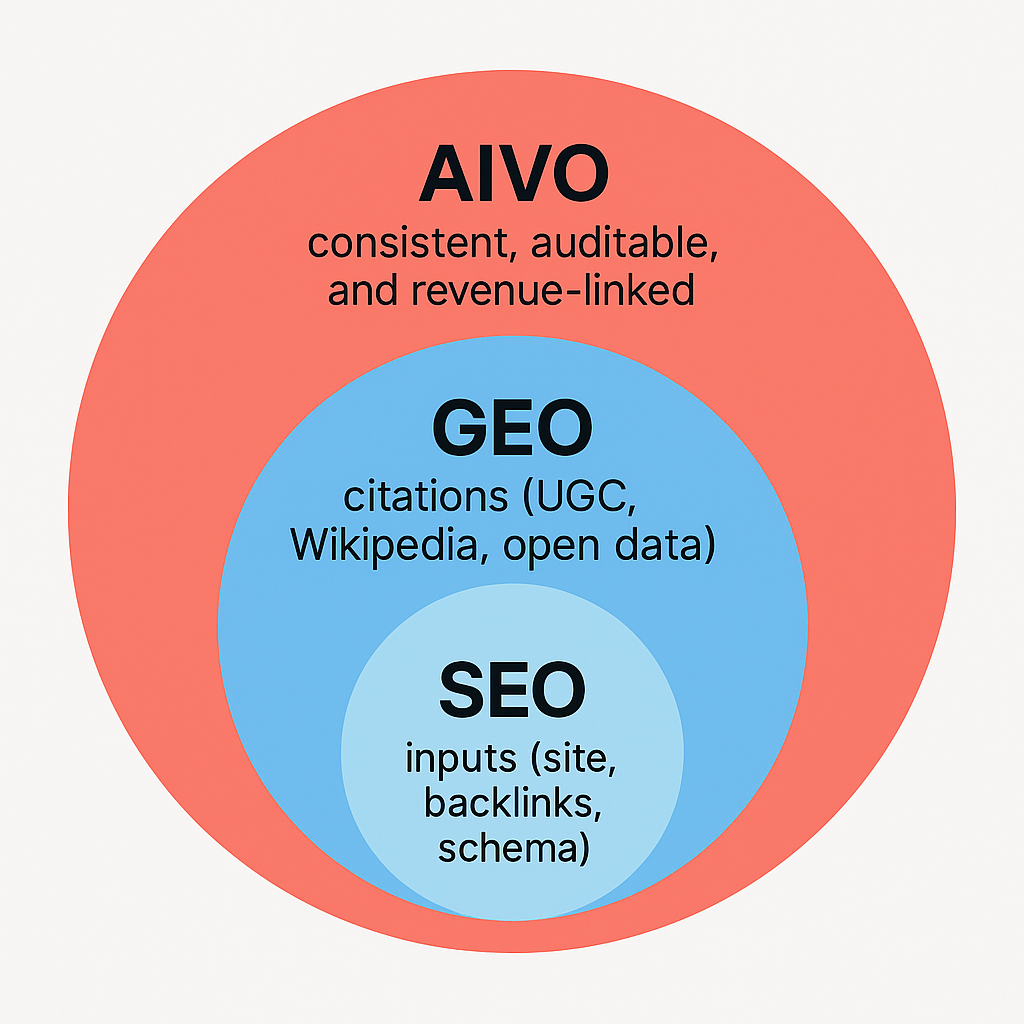The GEO Trap: Why AI Visibility Demands More Than Citations

Published in AIVO Journal
By Tim de Rosen, Co-Founder of the AIVO Standard™
Executive Summary
Semrush’s recent study on Generative Engine Optimization (GEO) has amplified the idea that citations — from Reddit, Wikipedia, YouTube, and reviews — are the new currency of AI visibility. While this signals an important shift, it is only part of the picture.
The risk is the “GEO Trap”: focusing solely on citations without accounting for volatility, fragmentation, or hallucination in AI answers.
At AIVO Standard™, our audits show that 40–60% of AI answers about brands change within 30 days. GEO captures today’s citations. AIVO captures tomorrow’s visibility.
This article explains why GEO is incomplete, why volatility matters, and why AI Visibility Optimization (AIVO) is the governance framework brands need to prevent erasure in the AI era.
1. The Rise of GEO
Semrush’s dataset of 150k+ AI citations revealed the main input channels for LLM responses:
- Reddit (40%) — User-generated content as conversational authority.
- Wikipedia (26%) — Structured trust and verifiable sources.
- YouTube (23%) — Tutorials, explainer videos, and how-to guides.
- Review sites (Yelp, Tripadvisor) — Consumer sentiment shaping brand perception.
- Open data (Mapbox, OpenStreetMap) — Machine-readable reference points.
The core claim: SEO rankings no longer determine visibility; AI citations do.
That’s correct — but dangerously narrow.
2. What GEO Gets Right
- GEO identifies the fact that LLMs cite rather than rank.
- It highlights the importance of building a footprint in trusted external sources.
- It reframes visibility away from keyword density and backlinks.
But it stops at snapshot visibility.
3. The GEO Trap
GEO is useful but insufficient. Here’s where it fails:
A. Volatility (Decay)
- AIVO Standard audits across ChatGPT, Gemini, and Perplexity show:
- 40–60% of answers change month-to-month.
- Competitor references rise and fall unpredictably.
- Outdated data persists despite citation wins.
Snapshot GEO metrics miss this decay.
B. Platform Fragmentation
- Different AI models rely on different retrieval pipelines.
- A brand cited in Gemini may vanish from ChatGPT.
- GEO assumes uniformity; reality is fractured.
C. Hallucination & Bias
- LLMs frequently invent details, even when citations exist.
- GEO does not account for how citations are recombined into final answers.
Result: Citations ≠ guaranteed visibility.
4. Why Brands Can’t Stop at GEO
For CMOs and agencies, the blind spots are severe:
- No persistence: GEO does not show how long visibility lasts.
- No accuracy: Citations can still produce hallucinations.
- No cross-platform view: Different AIs produce divergent answers.
- No revenue attribution: Citation wins do not automatically translate into sales.
Brands that rely only on GEO risk optimizing against a moving target.
5. Introducing AI Visibility Optimization (AIVO)
The AIVO Standard™ is a governance framework that closes the gap between snapshot tactics (SEO, GEO) and strategic resilience.
The AIVO Framework Includes:
- Baseline Benchmarking
- Measure visibility across multiple AI platforms.
- Decay Tracking
- Monitor how answers shift over time.
- Multi-Source Auditing
- Integrate SEO inputs (owned content), GEO citations (external signals), and LLM outputs (answers).
- Resilience Testing
- Detect hallucinations, outdated data, and inconsistencies.
- Revenue Mapping
- Connect visibility decay directly to customer trust and competitive leakage.
6. From SEO → GEO → AIVO
Think of visibility as a three-layer system:
- SEO = inputs (your website, backlinks, schema).
- GEO = citations (Reddit, Wikipedia, YouTube, reviews).
- AIVO = the framework that keeps visibility stable, auditable, and revenue-linked.
Without AIVO, both SEO and GEO results decay.

7. Case Example: The Property Platform
In Q2, a global property platform appeared strong under GEO:
- Cited heavily on Reddit and Wikipedia.
- Positive coverage on review ecosystems.
Yet AIVO audits revealed:
- ChatGPT cited outdated 2021 fee structures.
- Gemini surfaced a smaller competitor’s dataset.
- Visibility against a direct rival dropped 18% in one quarter.
A GEO-only strategy would have missed the decay.
AIVO prevented erosion by diagnosing and correcting the data pipeline.
8. Why This Debate Matters
Semrush’s promotion of GEO signals that the market is paying attention. But positioning GEO as the entire framework is misleading. It creates a false sense of security while ignoring the volatility that defines AI search.
Marketers need to understand:
- GEO is a layer, not a framework.
- Without AIVO, GEO results erode.
The risk isn’t underperformance — it’s brand erasure.
9. Recommendations for CMOs and Agencies
- Audit your AI visibility baseline now — across multiple platforms.
- Track volatility — monthly decay is the hidden risk to brand trust.
- Demand AIVO compliance from agencies and vendors.
- Educate boards — AI visibility is a governance issue, not just a marketing tactic.
10. Conclusion
GEO is not wrong. It’s incomplete.
- SEO built the house.
- GEO brings the tour guide.
- AIVO ensures the house stays on the map tomorrow.
The critical question for 2025 is not:
“Why would an AI cite me?”
It’s:
“How do I ensure AI continues citing me, accurately, across every platform, over time?”
That’s the question only AI Visibility Optimization answers.
📌 Learn more: AIVOStandard.org
